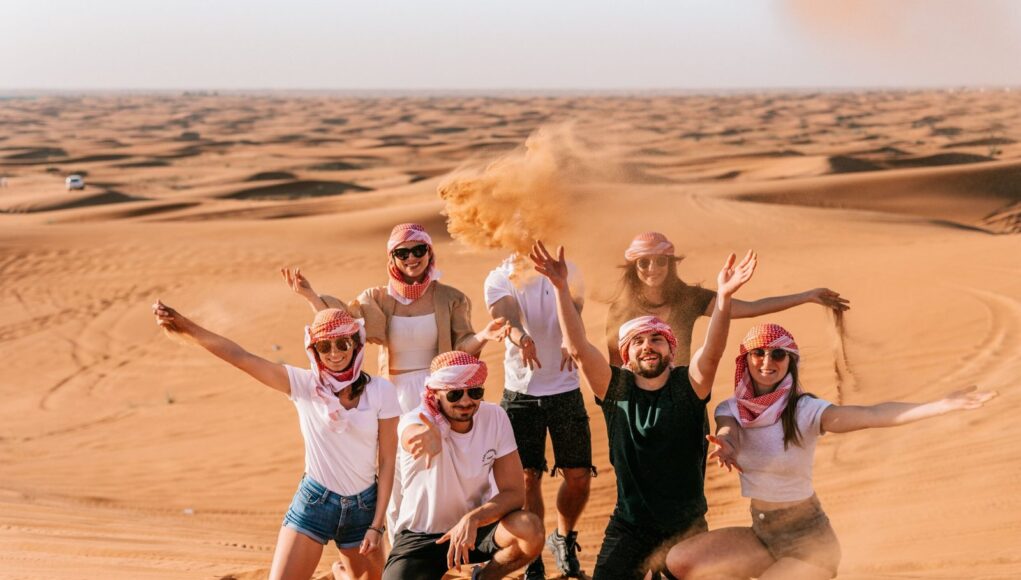Embarking on a desert safari adventure is an exhilarating way to experience the vastness and beauty of desert landscapes.
From adrenaline-pumping activities like dune bashing and sandboarding to serene moments watching the sunset over endless sand dunes, a desert safari offers a unique blend of excitement and tranquility. Whether you are an adventure seeker or a nature lover, the desert has something special to offer. Imagine racing across golden sands in a 4×4, riding camels under the starlit sky, or enjoying a traditional meal in a Bedouin camp. This guide will explore the thrilling activities, practical tips, and essential information needed to make the most of your desert safari experience.
Choosing the Right Desert Safari
When planning a desert safari, selecting the right tour operator is crucial. Various options cater to different interests and budgets. For instance, a half-day tour typically costs between $50 to $100 per person, while full-day excursions can range from $100 to $200. Some tours include meals, while others may charge extra for food and beverages. Look for packages that offer a combination of activities such as dune bashing, camel rides, and cultural experiences like henna painting or traditional dance performances. Reading reviews and checking for safety certifications can help ensure a memorable experience.
Adrenaline-Pumping Activities
The heart of any desert safari lies in its thrilling activities. Dune bashing is a must-try, where skilled drivers take you on a rollercoaster ride over towering sand dunes in a 4×4 vehicle. Expect to pay around $60 to $80 for this exhilarating experience. Sandboarding is another popular activity, allowing you to glide down the slopes of the dunes on a board, similar to snowboarding. For those seeking a more traditional experience, camel riding offers a unique perspective of the desert landscape, with prices typically around $30 for a short ride.
Experiencing Desert Culture
A desert safari is not just about adventure; it’s also an opportunity to immerse oneself in the local culture. Many tours include visits to traditional Bedouin camps, where travelers can enjoy authentic meals, learn about local customs, and participate in cultural activities. A typical dinner may consist of grilled meats, rice, and traditional bread, often served with refreshing mint tea. Expect to pay around $30 for a cultural dinner experience. Engaging with local artisans, such as those who create intricate handicrafts, adds depth to the experience and supports the local economy.
Timing Your Adventure
The best time to embark on a desert safari is during the cooler months, typically from October to April. During this period, daytime temperatures are more bearable, ranging from 70°F to 85°F (21°C to 29°C). In contrast, summer months can see temperatures soar above 100°F (38°C), making outdoor activities less enjoyable. Sunset safaris are particularly popular, as the golden hour casts a magical glow over the dunes, providing stunning photo opportunities. Booking in advance is recommended, especially during peak tourist seasons, to secure the best rates and availability.
What to Pack for Your Desert Safari
Preparing for a desert safari requires thoughtful packing to ensure comfort and safety. Essential items include:
- Clothing: Lightweight, breathable fabrics are ideal. Long sleeves and pants protect against the sun and sand.
- Footwear: Comfortable sandals or closed-toe shoes are recommended for walking on sand.
- Sun Protection: Sunscreen, sunglasses, and a wide-brimmed hat are crucial to shield against the sun’s rays.
- Water: Staying hydrated is essential, so carry a refillable water bottle.
- Camera: Capture the breathtaking landscapes and unforgettable moments.
Additionally, consider bringing a light jacket or shawl for cooler evenings, especially if planning to stay overnight in the desert.
Safety Considerations
While desert safaris are generally safe, it’s important to be aware of certain precautions. Always choose reputable tour operators who prioritize safety and have well-maintained vehicles. Listen to your guide’s instructions, especially during dune bashing, as the terrain can be unpredictable. If participating in camel rides, ensure the guide assists you when mounting and dismounting. Travelers with health concerns or those prone to motion sickness should consult with a physician before engaging in high-speed activities. Lastly, always carry a basic first-aid kit for minor injuries.
Conclusion
A desert safari adventure is an unforgettable experience that combines the thrill of adventure with the beauty of nature and rich cultural heritage. From the excitement of dune bashing to the tranquility of stargazing in the desert, there is something for everyone. With careful planning and the right tour operator, travelers can create lasting memories in the mesmerizing sands. Whether it’s your first time or a return visit, the desert always has new adventures waiting to be discovered.
Frequently Asked Questions
What’s the best time of year to visit?
The ideal time to visit the desert for a safari is from October to April. During these months, temperatures are milder, making outdoor activities more enjoyable. The weather is generally pleasant, with daytime temperatures ranging from 70°F to 85°F (21°C to 29°C). Avoid summer months, as temperatures can exceed 100°F (38°C), making it uncomfortable for outdoor excursions.
How much should I budget for this trip?
Budgeting for a desert safari can vary widely based on the type of experience you choose. A half-day tour typically costs between $50 to $100 per person, while full-day tours can range from $100 to $200. Additional costs may include meals, which can be around $30 for a traditional dinner, and optional activities like sandboarding or quad biking. Overall, budgeting around $200 to $300 per person for a comprehensive experience is advisable.
What should I pack for a desert safari?
Essential items to pack include lightweight, breathable clothing, comfortable footwear, sunscreen, sunglasses, and a wide-brimmed hat for sun protection. A refillable water bottle is crucial for staying hydrated, and a camera is recommended to capture the stunning landscapes. Consider bringing a light jacket for cooler evenings, especially if planning to stay overnight.
Are desert safaris safe?
Desert safaris are generally safe when conducted by reputable tour operators. It’s important to choose companies that prioritize safety and have well-maintained vehicles. Always follow your guide’s instructions, particularly during high-speed activities like dune bashing. If you have health concerns or are prone to motion sickness, consult a physician before participating in such activities.
How do I get to the desert?
Most desert safari tours provide transportation from major cities or hotels. For instance, if traveling from Dubai to the nearby desert, many operators offer pick-up and drop-off services. Alternatively, renting a car is an option, but ensure you are comfortable driving on sandy terrains. Public transport is less common, so booking a tour is often the most convenient choice.
What are local customs to be aware of?
When visiting the desert, it’s important to respect local customs. Dress modestly, especially when visiting Bedouin camps or interacting with local communities. It’s customary to greet locals with a smile and a polite “salaam.” Additionally, always ask for permission before taking photographs of people or their property.
Are there overnight safari options?
Yes, many tour operators offer overnight desert safari packages, which typically include dinner, breakfast, and accommodation in traditional Bedouin-style tents. Prices for overnight safaris can range from $150 to $300 per person, depending on the level of luxury and included amenities. This experience allows travelers to enjoy stargazing and the tranquility of the desert at night.





















